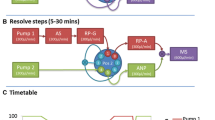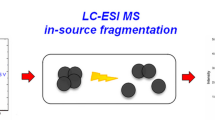Abstract
Identification of impurities in 5-aminolevulinic acid (ALA) by mass spectrometry is difficult, because MS-incompatible mobile phases, such as phosphate buffers or ion-pair reagents, need to be used to separate the major component from impurities. In this study, the unknown impurities in ALA have been identified by two-dimensional (2D) column-switching high-performance liquid chromatography (HPLC) coupled with linear ion trap mass spectrometry (LIT MS). The first-dimensional analytical column was a Gemini C18 (150 mm × 4.6 mm, 5 μm) with a non-volatile salt mobile phase at a flow rate of 1.0 mL min−1, and the second-dimensional analytical column was a ZORBAX SB C8 (150 mm × 4.6 mm, 3.5 μm) with a volatile salt mobile phase at a flow rate of 1.0 mL min−1. The detection wavelength was 205 nm. Mass spectra were acquired with an ESI source, in both positive and negative ion modes. Six impurities were identified by their MS2 and MS3 fragments, and the mass fragmentation patterns and structural assignments of these impurities were studied. The results obtained by the two-dimensional column-switching method were further compared with those of the conventional one-dimensional normal-phase HPLC–MS using an amide column and an MS-compatible mobile phase for separation. The two-dimensional column-switching method described herein proved to be advantageous in terms of the number of impurities identified. The column-switching and online demineralization technique made the mobile phase conditions compatible with mass spectrometry. Thus, the method solves the problem of incompatibility between non-volatile salt mobile phases and mass spectrometry, making it worthy of popularization and application in impurity identification.






Similar content being viewed by others
References
Benton CM, Lim CK, Moniz C, Jones DJL (2012) Travelling wave ion mobility mass spectrometry of 5-aminolaevulinic acid, porphobilinogen and porphyrins. Rapid Commun Mass Spectrom 26:480–486
Alsarra IA, Eldeen A, Yassin B, Abdel-Hamid M, Alanazi FK, Aljuffali IA (2011) Direct UPLC–MS–MS validated method for the quantification of 5-aminolevulinic acid: application to in vitro assessment of colonic-targeted oral tablets. J Chromatogr Sci 49:428–433
He CC, Guan J, Ding S, Yan F, Shi S, Niu QL (2013) Determination of 5-aminolevulinic acid and related four substances by reversed-phase ion-pair high-performance liquid chromatography. J. Shenyang Pharm Univ 9:696–700
Chen ZK, Peng XS, Wu W (2007) Study on determination of aminolevulinic acid and its related substances by RP-HPLC. Chin Pharm J 421:1895–1897
Floderus Y, Sardh E, Moller C, Andersson C, Rejkjaer L, Andersson DEH, Harper P (2006) Variations in porphobilinogen and 5-aminolevulinic acid concentrations in plasma and urine from asymptomatic carriers of the acute intermittent porphyria gene with increased porphyrin precursor excretion. Clin Chem 52:701–707
Bunke A, Zerbe O, Schmid H, Burmeister G, Merkle HP, Gander B (2000) Degradation mechanism and stability of 5-aminolevulinic acid. J Pharm Sci 891:1335–1341
Lord GA, Luo JL, Lim CK (2000) Capillary zone electrophoresis/mass spectrometry of 5-aminolaevulinic acid and porphobilinogen. Rapid Commun Mass Spectrom 14:314–316
Zhang JL, Yasuda M, Desnick RJ, Balwani M, Bishop D, Yu CL (2011) A LC-MS/MS method for the specific, sensitive, and simultaneous quantification of 5-aminolevulinic acid and porphobilinogen. J Chromatogr B 879:2389–2396
Benton CM, Couchman L, Marsden JT, Rees DC, Moniz C, Lim CK (2013) Direct and simultaneous quantitation of 5-aminolaevulinic acid and porphobilinogen in human serum or plasma by hydrophilic interaction liquid chromatography-atmospheric pressure chemical ionization/tandem mass spectrometry. Biomed Chromatogr 27:267–272
Benton CM, Couchman L, Marsden JT, Rees DC, Moniz C, Lim CK (2012) Direct and simultaneous determination of 5-aminolaevulinic acid and porphobilinogen in urine by hydrophilic interaction liquid chromatography-electrospray ionisation/tandem mass spectrometry. Biomed Chromatogr 26:1033–1040
Ren Q, Wu C, Zhang J (2013) Use of on-line stop-flow heart-cutting two-dimensional high-performance liquid chromatography for simultaneous determination of major constituents in tartary buckwheat (Fagopyrum tataricum Gaertn). J Chromatogr A 1304:257–262
Park M, Kim J, Park Y, In S, Kim E, Park Y (2014) Quantitative determination of 11-nor-9-carboxy-tetrahydrocannabinol in hair by column switching LC–ESI-MS3. J Chromatogr B 947–948:179–185
Neubauer W, Kig A, Bolekc R, Trittler R, Engelhardt M, Jung M, Kummerer K (2009) Determination of the antifungal agent posaconazole in human serum by HPLC with parallel column-switching technique. J Chromatogr B 877:2493–2498
Hu L, Boos KS, Ye M, Zou H (2014) Analysis of the endogenous human serum peptides by on-line extraction with restricted-access material and HPLC-MS/MS identification. Talanta 127:191–195
Essader AS, Cargile BJ, Bundy JL, Stephenson JL Jr (2005) A comparison of immobilized pH gradient isoelectric focusing and strong-cation-exchange chromatography as a first dimension in shotgun proteomics. Proteomics 5:24–34
Delmotte N, Lasaosa M, Tholey A, Heinzle E, Huber CG (2007) Two-dimensional reversed-phase x ion-pair reversed-phase HPLC: an alternative approach to high-resolution peptide separation for shotgun proteome analysis. J Proteome Res 6(11):4363–4373
Wang D, Chen LJ, Liu JL, Wang XY, Wu YL, Fang MJ, Wu Z, Qiu YK (2015) On-line two-dimensional countercurrent chromatography × high performance liquid chromatography system with a novel fragmentary dilution and turbulent mixing interface for preparation of coumarins from Cnidium monnieri. J Chromatogr A 1406:215–223
Stoll DR (2010) Recent progress in online, comprehensive two-dimensional high-performance liquid chromatography for non-proteomic applications. Anal Bioanal Chem 397:979–986
Wang H, Sun SN, Zhang Y, Chen S, Liu P, Liu B (2015) An off-line high pH reversed-phase fractionation and nano-liquid chromatography–mass spectrometry method for global proteomic profiling of cell lines. J Chromatogr B 974:90–95
Venkatramani CJ, Wigman L, Mistry K, Chetwyn N (2012) Simultaneous, sequential quantitative achiral–chiral analysis by two-dimensional liquid chromatography. J Sep Sci 35:1748–1754
Venkatramani CJ, Al-Sayah M, Li G, Goel M, Girotti J, Zang L, Wigman L, Yehl P, Chetwyn N (2016) Simultaneous achiral-chiral analysis of pharmaceutical compounds using two-dimensional reversed-phase liquid chromatography-supercritical fluid chromatography. Talanta 148:548–555
Li J, Xu L, Shi ZG, Hu M (2015) A novel two-dimensional liquid chromatographic system for the online toxicity prediction of pharmaceuticals and related substances. J Hazard Mater 293:15–20
Sheldon EM (2003) Development of a LC–LC–MS complete heart-cut approach for the characterization of pharmaceutical compounds using standard instrumentation. J Pharm Biomed Anal 31:1153–1166
Huidobro AL, Pruim P, Schoenmakers P, Barbas C (2008) Ultra rapid liquid chromatography as second dimension in a comprehensive two-dimensional method for the screening of pharmaceutical samples in stability and stress studies. J Chromatogr A 1190:182–190
Alexander AJ, Ma LJ (2009) Comprehensive two-dimensional liquid chromatography separations of pharmaceutical samples using dual Fused-Core columns in the 2nd dimension. J Chromatogr A 1216:1338–1345
Zhang J, Lanham KA, Heideman W, Peterson RE, Li L (2013) Characterization of zebrafish cardiac proteome using online pH gradient SCX-RP HPLC-MS/MS platform. Methods Mol Biol 1005:119–127
Zhang K, Li Y, Tsang M, Chetwyn NP (2013) Analysis of pharmaceutical impurities using multi-heartcutting 2D LC coupled with UV-charged aerosol MS detection. J Sep Sci 36:2986–2992
He GX, Dahl T (2000) Improved high-performance liquid chromatographic method for analysis of l-carnitine in pharmaceutical formulations. J Pharm Biomed Anal 15:315–321
Yamamoto T (2015) Method for microbial manufacture of 5-aminolevulinic acid or salt thereof. Jpn. Kokai Tokkyo Koho, 2015181459 (22) JP 2015181459
McCarron PA, Donnelly RF, Andrews GP, Woolfson AD (2005) Stability of 5-aminolevulinic acid in novel non-aqueous gel and patch-type systems intended for topical application. J Pharm Sci 94:1756–1771
Acknowledgments
This work was supported by the National Natural Science Foundation of China (Grant No. 21405104) and the Youth Initial Foundation of Shanghai Jiao Tong University.
Author information
Authors and Affiliations
Corresponding author
Ethics declarations
Conflict of interest
All authors declare that they have no conflict of interest.
Ethical approval
This article does not contain any studies with human participants or animals performed by any of the authors.
Electronic supplementary material
Below is the link to the electronic supplementary material.
Rights and permissions
About this article
Cite this article
Wang, H., Xie, S. Identification of Impurities in 5-Aminolevulinic Acid by Two-Dimensional Column-Switching Liquid Chromatography Coupled with Linear Ion Trap Mass Spectrometry. Chromatographia 79, 1469–1478 (2016). https://doi.org/10.1007/s10337-016-3165-2
Received:
Revised:
Accepted:
Published:
Issue Date:
DOI: https://doi.org/10.1007/s10337-016-3165-2




